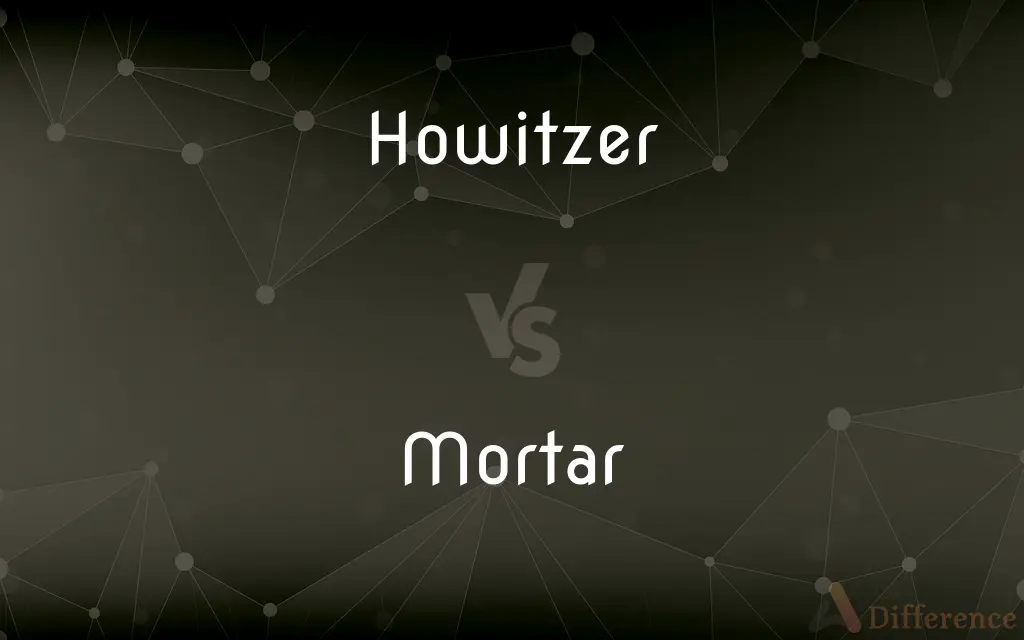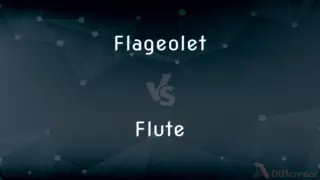Howitzer vs. Mortar — What's the Difference?
Edited by Tayyaba Rehman — By Maham Liaqat — Updated on March 26, 2024
Howitzer is artillery piece designed for high-angle fire with relatively long barrel, capable of firing shells on high trajectories. Mortar is a simple, lightweight, and portable artillery piece firing shells at high angles for short-range indirect fire.

Difference Between Howitzer and Mortar
Table of Contents
ADVERTISEMENT
Key Differences
Howitzers are versatile artillery pieces that combine the characteristics of guns and mortars, capable of firing shells at a wide range of angles. They are designed for both direct (line-of-sight) and indirect (beyond line-of-sight) fire, making them suitable for various battlefield roles, including destroying fortifications, providing fire support, and engaging enemy troops. On the other hand, mortars are relatively simple and lightweight weapons, designed primarily for high-angle fire. They are used for indirect fire support, particularly in close support roles within smaller units.
Howitzers are mounted on various platforms, including trucks, tanks, and dedicated artillery systems, which provide stability and mobility. This versatility allows howitzers to be used in diverse operational scenarios, from static defense positions to mobile warfare. They require a crew to operate and are often part of larger artillery units. Mortars, in contrast, range from small, man-portable units that can be operated by a single soldier or a small team to larger, more powerful systems requiring vehicle transport. Their simplicity and portability make mortars an essential part of infantry units, providing them with the ability to quickly deploy high-angle fire against obscured or entrenched enemy positions.
The ammunition used by howitzers and mortars also differs in terms of size, range, and explosive power. Howitzer shells are generally larger and have more sophisticated fuze options, allowing for a variety of detonation modes, such as airburst, impact, or proximity fuzes, tailored to specific target types and battlefield conditions. Mortar shells are smaller and simpler, designed for area suppression and achieving effects such as fragmentation, smoke, or illumination over a specific target area. Despite their simplicity, modern mortars can be highly effective, especially with precision-guided munitions that enhance their accuracy.
Operational roles of howitzers and mortars are distinguished by their range, mobility, and tactical flexibility. Howitzers are often employed for tasks requiring longer-range engagements, such as interdicting supply lines, counter-battery fire, and supporting assaults over extended battlefields. Mortars, with their shorter range, are more suited to tactical support within the immediate battlefield environment, such as suppressing enemy infantry, disrupting light vehicles, and providing smoke cover for movements or withdrawals.
Both howitzers and mortars play crucial roles in modern combined arms warfare, offering commanders a range of options for delivering indirect fire. While howitzers provide long-range, versatile support capable of engaging targets in depth, mortars offer rapid, flexible fire support closely integrated with infantry operations. The choice between howitzer and mortar support often depends on the specific tactical situation, including factors like the range to the target, the type of terrain, and the mobility requirements of the unit.
ADVERTISEMENT
Comparison Chart
Design
Longer barrel, capable of both high and low-angle fire.
Shorter barrel, designed for high-angle fire only.
Mobility
Mounted on vehicles for mobility, requires crew.
Ranges from man-portable to vehicle-mounted, simpler.
Range
Longer range, suitable for both direct and indirect fire.
Shorter range, primarily for indirect fire.
Ammunition
Larger shells, more sophisticated fuze options.
Smaller, simpler shells, with options for various effects.
Operational Role
Versatile use in diverse scenarios, including counter-battery fire and supporting assaults.
Close support within infantry units, quick deployment in varied terrains.
Compare with Definitions
Howitzer
A versatile artillery piece for high and low-angle fire.
The howitzer unit provided crucial support during the assault, targeting enemy fortifications.
Mortar
Ranges from man-portable to larger, crew-served systems.
The platoon's man-portable mortar was crucial for their mobility.
Howitzer
Designed for long-range, direct, and indirect engagements.
The army deployed howitzers to the front line for their extended range capability.
Mortar
A lightweight, high-angle fire weapon for indirect support.
Infantry units used mortars to suppress enemy positions ahead of their advance.
Howitzer
Mounted on mobile platforms for operational flexibility.
Mobile howitzers were repositioned overnight to support the new offensive.
Mortar
Primarily designed for short-range engagements.
The mortar team quickly set up to engage the enemy trench system.
Howitzer
Integral to combined arms warfare, supporting broader strategic objectives.
Strategically placed howitzers played a key role in the battle's outcome.
Mortar
Essential for close support and flexible tactical use.
Mortars were deployed to target enemy units obscured by the forest.
Howitzer
Utilizes larger ammunition for a variety of effects.
The howitzers fired airburst shells to neutralize enemy troops in open terrain.
Mortar
Fires smaller, simple shells for area effects.
Mortars provided smoke cover, enabling the troops to maneuver safely.
Howitzer
A howitzer () is a long-ranged weapon, falling between a cannon (also known as artillery gun in the U.S.), which fires shells at flat trajectories, and a mortar, which fires at high angles of ascent and descent. Howitzers, like other artillery equipment, are usually organized in a group called a battery.
Mortar
A short smooth-bore gun for firing shells (technically called bombs) at high angles
Mortars and machine guns
Nine civilians died in a horrific mortar attack
Howitzer
A relatively short cannon that delivers shells at a medium muzzle velocity, usually by a high trajectory.
Mortar
A cup-shaped receptacle in which ingredients are crushed or ground, used in cooking or pharmacy
A pestle and mortar
Howitzer
A cannon that combines certain characteristics of field guns and mortars, delivering projectiles with medium velocities, usually with relatively high trajectories; normally a cannon with a tube length of 20 to 30 calibers.
Mortar
A mixture of lime with cement, sand, and water, used in building to bond bricks or stones.
Howitzer
A powerfully hit shot.
Mortar
Attack or bombard with a mortar
At first light the mortaring and sniping started
The Commando positions were being heavily mortared
Howitzer
To attack with a howitzer.
Mortar
Fix or join using mortar
The pipe can be mortared in place
Howitzer
A gun so short that the projectile, which was hollow, could be put in its place by hand; a kind of mortar.
Mortar
A vessel in which substances are crushed or ground with a pestle.
Howitzer
A muzzle-loading high-angle gun with a short barrel that fires shells at high elevations for a short range
Mortar
A machine in which materials are ground and blended or crushed.
Mortar
A portable, usually muzzleloading cannon used to fire shells at low velocities, short ranges, and high trajectories.
Mortar
A shell fired by such a cannon.
Mortar
Any of several similar devices, such as one that shoots life lines across a stretch of water.
Mortar
A short, usually stationary, muzzleloading cannon used from the 1700s to early 1900s to fire large round shells at low velocities, short ranges, and high trajectories.
Mortar
Any of various bonding materials used in masonry, surfacing, and plastering, especially a mixture of cement or lime, sand, and water that hardens in place and is used to bind together bricks or stones.
Mortar
To bombard with mortar shells.
Mortar
To plaster or join with mortar.
Mortar
(uncountable) A mixture of lime or cement, sand and water used for bonding building blocks.
Mortar
(countable) A muzzle-loading, indirect fire weapon with a tube length of 10 to 20 calibers and designed to lob shells at very steep trajectories.
Mortar
(countable) A hollow vessel used to pound, crush, rub, grind or mix ingredients with a pestle.
Mortar
(countable) In paper milling, a trough in which material is hammered.
Mortar
(transitive) To use mortar or plaster to join two things together.
Mortar
(transitive) To pound in a mortar.
Mortar
To fire a mortar (weapon).
Mortar
To attack (someone or something) using a mortar (weapon).
The insurgents snuck up close and mortared the base last night.
Mortar
A strong vessel, commonly in form of an inverted bell, in which substances are pounded or rubbed with a pestle.
Mortar
A short piece of ordnance, used for throwing bombs, carcasses, shells, etc., at high angles of elevation, as 45°, and even higher; - so named from its resemblance in shape to the utensil above described.
Mortar
A building material made by mixing lime, cement, or plaster of Paris, with sand, water, and sometimes other materials; - used in masonry for joining stones, bricks, etc., also for plastering, and in other ways.
Mortar
A chamber lamp or light.
Mortar
To plaster or make fast with mortar.
Mortar
A muzzle-loading high-angle gun with a short barrel that fires shells at high elevations for a short range
Mortar
Used as a bond in masonry or for covering a wall
Mortar
A bowl-shaped vessel in which substances can be ground and mixed with a pestle
Mortar
Plaster with mortar;
Mortar the wall
Common Curiosities
How does a mortar differ from other artillery pieces?
Mortars are distinguished by their simplicity, portability, and high-angle fire capability, making them ideal for short-range, indirect fire support within infantry units.
Can howitzers be used for anti-aircraft purposes?
While not designed as anti-aircraft weapons, modern howitzers with sophisticated fire control systems can engage slow-moving or low-flying aerial targets under certain conditions.
How do the operational roles of howitzers and mortars complement each other in modern warfare?
In modern warfare, howitzers provide long-range fire support and operational flexibility, while mortars offer rapid, short-range, high-angle fire support, especially suited to the tactical needs of infantry units.
What types of units typically operate mortars?
Mortars are typically operated by infantry units for close support, but larger, vehicle-mounted systems may be operated by dedicated mortar units or artillery formations.
How do environmental conditions affect the use of howitzers and mortars?
Environmental conditions like weather, terrain, and atmospheric pressure can affect the range and accuracy of both howitzers and mortars. Operators adjust firing parameters to compensate for these variables.
Can mortars be used defensively?
Yes, mortars can be used defensively to break enemy assaults, create smoke screens, and lay down suppressive fire to protect friendly positions.
What advancements have been made in howitzer technology?
Advancements include automated loading systems, improved mobility platforms, enhanced targeting systems, and the use of precision-guided munitions for increased accuracy.
What are the primary uses of a howitzer?
Howitzers are used for a wide range of fire support missions, including destroying fortifications, providing fire support, and engaging targets at both direct and indirect fire ranges.
What makes mortars preferred in mountainous or dense terrain?
Mortars are preferred in such terrains due to their portability, ease of setup, and ability to fire shells in a high arc, allowing them to hit targets that are otherwise obstructed.
What are the limitations of using mortars in urban warfare?
In urban warfare, the use of mortars is limited by the need for line-of-sight to targets, the risk of collateral damage, and the challenges of firing from confined spaces. However, they remain valuable for their ability to engage hidden or fortified positions.
How do howitzers support combined arms operations?
Howitzers support combined arms operations by providing versatile fire support that can be coordinated with infantry, armor, and air forces to create a unified offensive or defensive effort.
Are howitzers capable of firing precision-guided munitions?
Yes, modern howitzers can fire precision-guided munitions, significantly enhancing their accuracy and reducing collateral damage.
Are there specific training requirements for operating mortars vs. howitzers?
Yes, operating howitzers generally requires more specialized training due to their complexity and the range of ammunition types. Mortar crews also require specific training, focusing on rapid deployment and high-angle firing techniques.
What logistical considerations affect the deployment of howitzers and mortars?
Logistical considerations include the transportability of the system, ammunition supply, and the ability to quickly deploy and redeploy the weapon system. Mortars are more logistically simple due to their lighter weight and portability.
How does the range of a mortar compare to that of a howitzer?
Mortars typically have a shorter range than howitzers, designed for close to medium-range engagements, whereas howitzers can engage targets at longer distances.
Share Your Discovery

Previous Comparison
Polytone vs. Monotone
Next Comparison
Flageolet vs. FluteAuthor Spotlight
Written by
Maham LiaqatEdited by
Tayyaba RehmanTayyaba Rehman is a distinguished writer, currently serving as a primary contributor to askdifference.com. As a researcher in semantics and etymology, Tayyaba's passion for the complexity of languages and their distinctions has found a perfect home on the platform. Tayyaba delves into the intricacies of language, distinguishing between commonly confused words and phrases, thereby providing clarity for readers worldwide.















































